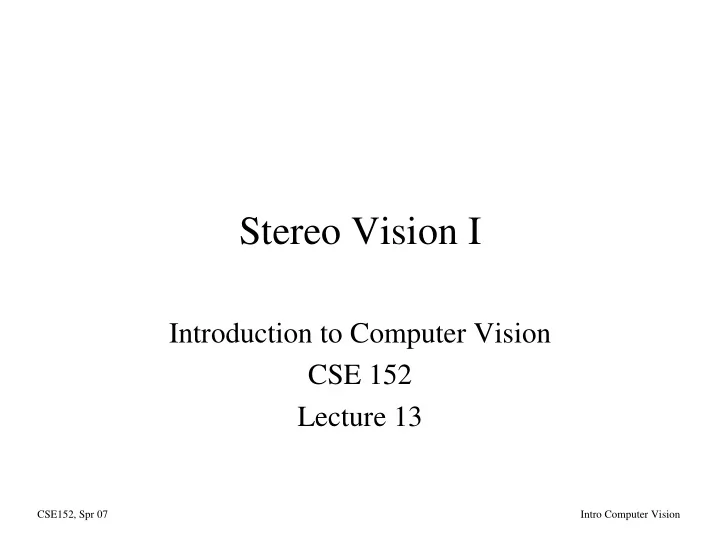

Stereo Vision I Introduction to Computer Vision CSE 152 Lecture 13 CSE152, Spr 07 Intro Computer Vision
Announcements • Midterm Percentage Score • Out of Mean 67 52. • 78 pts. Median 62 48 High 96 75 Low 24 18 CSE152, Spr 07 Intro Computer Vision
Shape-from-X (i.e., Reconstruction) • Methods for estimating 3-D shape from image data. X can be one (or more) of many cues. – Stereo (two or more views, known viewpoints) – Motion (moving camera or object) – Shading – Changing lighting (Photometric Stereo) – Texture variation – Focus/blur – Prior knowledge/context – structured light/lasers CSE152, Spr 07 Intro Computer Vision
Binocular Stereopsis: Mars Given two images of a scene where relative locations of cameras are known, estimate depth of all common scene points. Two images of Mars CSE152, Spr 07 Intro Computer Vision
Mar Rovers: Spirit and Opportunity Four pairs of stereo cameras CSE152, Spr 07 Intro Computer Vision
An Application: Mobile Robot Navigation The INRIA Mobile Robot, 1990. The Stanford Cart, H. Moravec, 1979. Courtesy O. Faugeras and H. Moravec. CSE152, Spr 07 Intro Computer Vision
Commercial Stereo Heads Binocular stereo Binocular stereo Trinocular stereo Trinocular stereo CSE152, Spr 07 Intro Computer Vision
Stereo can work well CSE152, Spr 07 Intro Computer Vision
Need for correspondence Truco Fig. 7.5 CSE152, Spr 07 Intro Computer Vision
Triangulation Nalwa Fig. 7.2 CSE152, Spr 07 Intro Computer Vision
Stereo Vision Outline • Offline: Calibrate cameras & determine “epipolar geometry” B • Online 1. Acquire stereo images C 2. Rectify images to convenient epipolar geometry D 3. Establish correspondence A 4. Estimate depth CSE152, Spr 07 Intro Computer Vision
BINOCULAR STEREO SYSTEM Estimating Depth DISPARITY (X L - X R ) Z Z = (f/X L ) X Z= (f/X R ) (X-d) (f/X L ) X = (f/X R ) (X-d) X = (X L d) / (X L - X R ) X L X R Z=f d X L X = (X L - X R ) X (0,0) (d,0) d f Z = (X L - X R ) (Adapted from Hager) CSE152, Spr 07 Intro Computer Vision
Reconstruction: General 3-D case Goal: Given two image measurements p and p’, estimate P. • Linear Method: find P such that • Non-Linear Method: find Q minimizing where q=MQ and q’=M’Q CSE152, Spr 07 Intro Computer Vision
Two Approaches 1. Feature-Based – From each image, process “monocular” image to obtain image features or cues(e.g., corners, lines). – Establish correspondence between the detected features. 2. Area-Based – Directly compare image regions between the two images. CSE152, Spr 07 Intro Computer Vision
Human Stereopsis: Binocular Fusion How are the correspondences established? Julesz (1971): Is the mechanism for binocular fusion a monocular process or a binocular one?? • There is anecdotal evidence for the latter (camouflage). • Random dot stereograms provide an objective answer CSE152, Spr 07 Intro Computer Vision
Random Dot Stereograms CSE152, Spr 07 Intro Computer Vision
Random Dot Stereograms CSE152, Spr 07 Intro Computer Vision
Recommend
More recommend